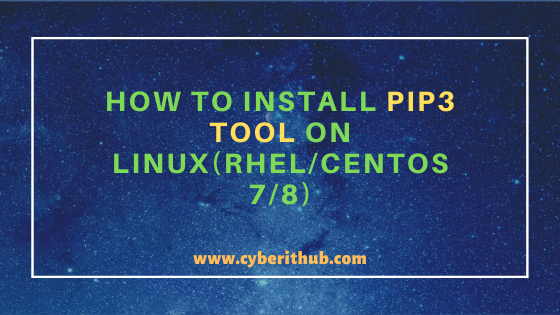

You can alter the output format of the command to only output up-to-date packages, outdated packages, or packages that do not have dependencies. Pip also equips you with the ability to generate a list of the packages installed for Python on your computer.Įntering “pip list” on the interpreter should give you a similar output: pip list However, depending on the environment, pip can also be used on Python3.
#INSTALL PIP3 CODE#
Location: /usr/local/lib/python2.7/site-packagesīear in mind that the code above shows that the pip command installs packages in …/python2.7/site. Summary: The PyPA recommended tool for installing Python packages.
#INSTALL PIP3 LICENSE#
Running the code to find the license and dependencies of pip should give a similar result as below if pip is installed on the machine: pip show pip If you’re unsure whether you have pip installed or not, you can use the pip show command to find the details of any installed package. Checked the Details of an Installed Package Pip2 can be used to manage packages in Python2, and pip3 can be used for package management in Python3.
#INSTALL PIP3 INSTALL#
For instance, if you set up pip to work with Python3, the packages you install with it will not work on Python2. Pip can be set up to work on either Python2 or Python3 on one machine. If you have installed Python2 and Python3 on your computer, you should be able to use pip2 and pip3 in addition to using the pip command. However, setting up a fresh Python environment with the installer is often easier. This will work on both Windows and macOS machines. If you are using a modified version of Python, you can install pip using get-pip.py or ensurepip. Redistributors typically remove the ensurepip module from the Python install. Pip is also automatically installed if you work in a virtual environment or use a Python version that isn’t modified by a redistributor. If you install Python on your computer using the installer on, pip is installed along with Python. Operations of Pip Explained Installing pip

This brief guide covers everything you need to know.
#INSTALL PIP3 HOW TO#
You also need to understand how to update packages and uninstall packages that you don’t need. However, before you can use a package, you will need to install it using pip, which is Python’s default package manager. Each package comes with several functions that you can use in your code. You can import packages such as matplotlib and numpy into a project. They remove the need for writing code that’s already been written. Python packages comprise large chunks of code that you can repeatedly use in different programs. The pip3 package is named as python3-pip. Install pip3 for Ubuntu, Debian, and Mintĭebian, Ubuntu, and Mint use the package base the pip3 can be installed on all of them with the following apt install command. 'pip3' is not recognized as an internal or external command, operable program or batch file.

If the pip3 is not installed on a Windows operating system the error message will be like below. Command 'pip3' not found, but can be installed with: If the pip3 is not installed on a Debian, Ubuntu, or Mint system the following error message is displayed. $ pip3 -V pip 20.3.4 from /usr/lib/python3/dist-packages/pip (python 3.9) If the pip3 is installed already the version information of the pip3 command will be shown like below. We can check the pip3 if it is installed previously by using it with the -v option which is used to show the pip3 command version. The pip3 may be installed previously for the current operating system and we may do not need to install it again. In this tutorial, we examine how to install pip3 for different operating systems and platforms. The pip3 command can be used with Python installation which can be Windows, Ubuntu, Debian even MacOSX. The pip3 is created to manage these modules or libraries by searching, installing, updating, removing them. Python provides a lot of modules and libraries by default but as a popular programming language, there are also a lot of 3rd party modules and libraries. The pip3 is the official Python package manager in order to install 3rd party modules.


 0 kommentar(er)
0 kommentar(er)
